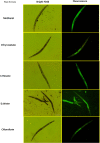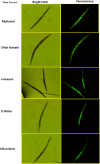Nematicidal Characterization of Solanum nigrum and Mentha arvensis Leaf Extracts Using Caenorhabditis elegans as a Model Organism
- PMID: 36936282
- PMCID: PMC10018721
- DOI: 10.1021/acsomega.2c08124
Nematicidal Characterization of Solanum nigrum and Mentha arvensis Leaf Extracts Using Caenorhabditis elegans as a Model Organism
Abstract
Considering foremost global issues instigated by parasitic nematodes, Solanum nigrum (S. nigrum) and Mentha arvensis (M. arvensis) nematicidal potential at the gene level has been explored herein. Methanol, ethyl acetate, chloroform, n-hexane, and distilled water were used for extract preparation. Caenorhabditis elegans (C. elegans) was used as the model organism. Nematicidal and anti-egg hatching assays, fluorescence microscopy, and quantitative real-time PCR were done. S. nigrum chloroform (LD50 = 1.21 mg/mL) and M. arvensis methanol (LD50 = 2.47 mg/mL) extracts exhibited excellent nematicidal potential. Both plants showed potent anti-egg hatching activity (1 mg/mL). S. nigrum methanol and M. arvensis ethyl acetate extracts showed high apoptotic effect in muscles, gonads, and uterus (eggs). Stress genes, that is, gst-4, hsp-16.2, and gpdh-1 were highly expressed in affected C. elegans (treated with S. nigrum and M. arvensis leaf extracts) when compared with normal C. elegans. Phytochemicals and bioactive compounds present in plants may be the major cause of their excellent nematicidal potential, which further confirmed that both plants could be an alternative candidate(s) for novel broad-scale anthelmintic drug(s).
© 2023 The Authors. Published by American Chemical Society.
Conflict of interest statement
The authors declare no competing financial interest.
Figures








References
LinkOut - more resources
Full Text Sources
Research Materials

